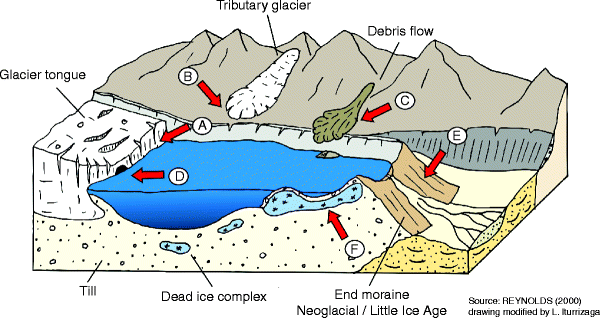
GLACIAL LAKE OUTBURST FLOOD (GLOF)
CONTEXT
- Using remote sensing data, researchers from Germany have mapped the evolution of Gya glacial lake outburst flood (GLOF) of 2014 in Ladakh.
BACKGROUND
- Report by researcher’s mentions that cause of GLOF was not a spill over due to an avalanche or
- landslide, rather there was a thawing of the ice cores in the moraine which drained through the subsurface tunnels. Moraine is any accumulation of unconsolidated debris, sometimes referred to as glacial till, that has been previously carried along by a glacier or ice sheet.
- Researchers noted that such thawing of ice cores may accelerate in the future
- due to climate change, and there is an urgent need to use multiple methods for better risk assessment and early warning.
- According to report, bathymetric studies are needed to analyse lake volumes and its dynamics. New, technologies can also be put to understand the stability of the moraines, but also need to asses land use planning.
ABOUT GLACIAL LAKES AND GLOFS
- Glacial lakes are ice-dammed, moraine-dammed, and bedrock-dammed lakes.These lakes are formed by the trapping of melt water from the glacier within dammed structure.
- Due to global warming glaciers are retreating and glacier lakes are expanding in the size and numbers.
- Glacial lake outburst flood (GLOF) is a sudden release of a significant amount of water retained in a glacial lake, irrespective of the cause.
- The formation of moraine-dammed glacial lakes and glacial lake outburst flood (GLOF) is major concern in the Himalayan states of India.
FACTORS TRIGGERING GLOFS
- Rapid slope movement into the lake: Fast slope movement (slides, falls and avalanches) into the lake produces displacement waves which, in turn overtop the dam or cause direct rupture of the dam.
- Increased water inflow into a lake due to heavy rainfall/snowmelt & cascading processes (flood from a lake situated upstream)
- Earthquake: The direct mechanism of earthquake-triggered lake outburst floods is dam rupture and failure.
- Long-term dam degradation: Successive changes in the internal structure of the dam leading to increased hydrostatic pressure induced by basal ice melting that results in dam failure.
- Black carbon: Due to incomplete combustion of fossil fuels, wood and other fuels amount of black carbon is increasing, which reduces the albedo of earth and melts the glaciers.
- Anthropogenic activities: Mass tourism, developmental interventions such as roads and hydropower projects and the practice of slash and burn type of farming in certain pockets of the Indian Himalayan region.
IMPACT OF GLOFS
- Societal Impact: The sudden and intense flooding that results can cause destruction and disruption of property, infrastructure and deaths.
- Impact on ocean circulation and climate: Sudden release of an extremely large amount of cold freshwater into the ocean reduces the salinity of the surface layer and subsequently alters ocean circulation. This also influence the associated climate.
- Geomorphological impact: GLOFs, have significant potential to influence erosion-accumulation interactions and sediment dynamics, like bank and depth erosion of the stream/river channel, meander shift, replacement of existing channels and formation of new ones or formation of erosional terraces etc.
STEPS TAKEN TO ALLEVIATE THREAT OF GLOF
- Indian Space Research Organization (ISRO) among many other Organisations are engaged in glacial lake monitoring and water bodies in the Himalayan region of Indian River Basins.
- National Disaster Management Authority (NDMA) guidelines for management of Glacial Lake Outburst Floods (GLOFs):
Hazard and risk mapping: Hazard and risk assessment provide the basis for prioritising, designing, and implementing risk management strategies, and is therefore considered to be a cornerstone of Disaster Risk Management.
- Monitoring, risk reduction and mitigation measures: Early Warning Systems (EWS) are commonly agreed upon as the most effective approach to disaster risk red.
- Awareness and preparedness: Building awareness and strengthening preparedness can be effective on short, mid, and longer time. In particular, attention should be given to the most vulnerable members of society, including women, children, disabled, elderly, and marginalised communities
- Capacity development: A successful and sustainable implementation of the framework for GLOF risk assessment and management requires scientific, management, engineering and institutional capacities. Efforts to develop capacities should focus both on training and strengthening academic education in relevant disciplines from natural and social sciences.
- Disaster response: Well-established disaster response procedures at national, state district, and community levels. Also, response strategies need to consider a multi-hazard perspective, considering access and evacuation routes and relief camps.
- Research and development: Repeated monitoring using advanced space-borne and terrestrial technology is required for regular re-assessment of lakes across the entire Himalayan region.
- Action plan and implementation: Comprehensive disaster management plans will be prepared at the National, State and District levels.
- Sikkim has installed a Lake monitoring and information System (water level Sensor) at South Lhonak lake. The sensor gives the water level of the lake and also monitored the lake level when there is sudden fluctuation in water level. Also high density polyethylene (HDPE) pipes have been installed to siphon off water from the glacial lake.
